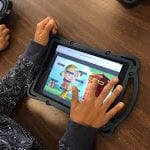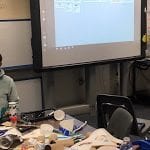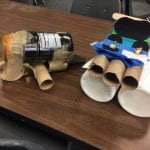Thinking about Building a New Car
Each week classes enter into a Makerspace lab for a design challenge. They may build a cardboard arcade game, bridge for a turkey to escape the inevitable or a video game based on the four layers of the ocean.
 Recently a third grade class came into the Makerspace Lab and handed an ipad. This was atypical because in the past a conversation was had about what would be built. Although a fine system, it left out the pieces of planning anThis room is so successful because it allows every student, every type of learner and all content areas to be combined into an activity where all members of a class can excel. What makes a Makerspace Lab so successful is the creativity, communication, collaboration, critical thinking (4 C’s in education) and the design thinking model. At no time will you find students sitting quietly, unengaged and waiting for a direction. There is a challenge that all students will find their strength and can add to the process. They are given a task, more recyclable and craft items they can get their hands on and a time frame to achieve it.
Recently a third grade class came into the Makerspace Lab and handed an ipad. This was atypical because in the past a conversation was had about what would be built. Although a fine system, it left out the pieces of planning anThis room is so successful because it allows every student, every type of learner and all content areas to be combined into an activity where all members of a class can excel. What makes a Makerspace Lab so successful is the creativity, communication, collaboration, critical thinking (4 C’s in education) and the design thinking model. At no time will you find students sitting quietly, unengaged and waiting for a direction. There is a challenge that all students will find their strength and can add to the process. They are given a task, more recyclable and craft items they can get their hands on and a time frame to achieve it.
d evaluation-two integral parts of the engineering process. On this day, the ipad would be the tool that allowed time for this to happen. Using SMART Technologies SMART Learning Suite Online activities (SLOS), a free part of their software, students logged in and completed a Rank Order activity. Nine thoughts were presented and they had to sort them from the first step to the last step while sitting in their groups. There was no right or wrong order stated and left much discussion to be had. Some groups agreed right away while others debated about the best way to tackle the challenge.
Once complete, the challenge was presented to the students. You have 40 minutes to build a car. No rules, no descriptions, no list of items that need to be used…only to build
 a car. The discussions and what some may call a disaster,commenced as a variety of tools was spread across the room. Conversations ensued as the builders spoke about what tools would be best for their car. As they were building, they returned to the SLSO Lab activities but this time a Shout It Out was used. Three columns were set up (materials, challenges and successes) where students filled it out as they build their vehicles. Finally, they needed to complete a 5 open-ended questions where they evaluated the process, tools used, collaboration and successes.
a car. The discussions and what some may call a disaster,commenced as a variety of tools was spread across the room. Conversations ensued as the builders spoke about what tools would be best for their car. As they were building, they returned to the SLSO Lab activities but this time a Shout It Out was used. Three columns were set up (materials, challenges and successes) where students filled it out as they build their vehicles. Finally, they needed to complete a 5 open-ended questions where they evaluated the process, tools used, collaboration and successes.
What did the engineers learn? By completing the different SLSO activities, the students were able to focus more on the path to success instead of only achieving the goal. The following week, the students received the same activities and a new goal. Using it a second time the students were ready for the process of the Makerspace planning and 4 C’s to a goal that they all achieved. 
This process will be discussed in greater detail on Sunday, December 2, 2018 at VSTE’s Conference.
